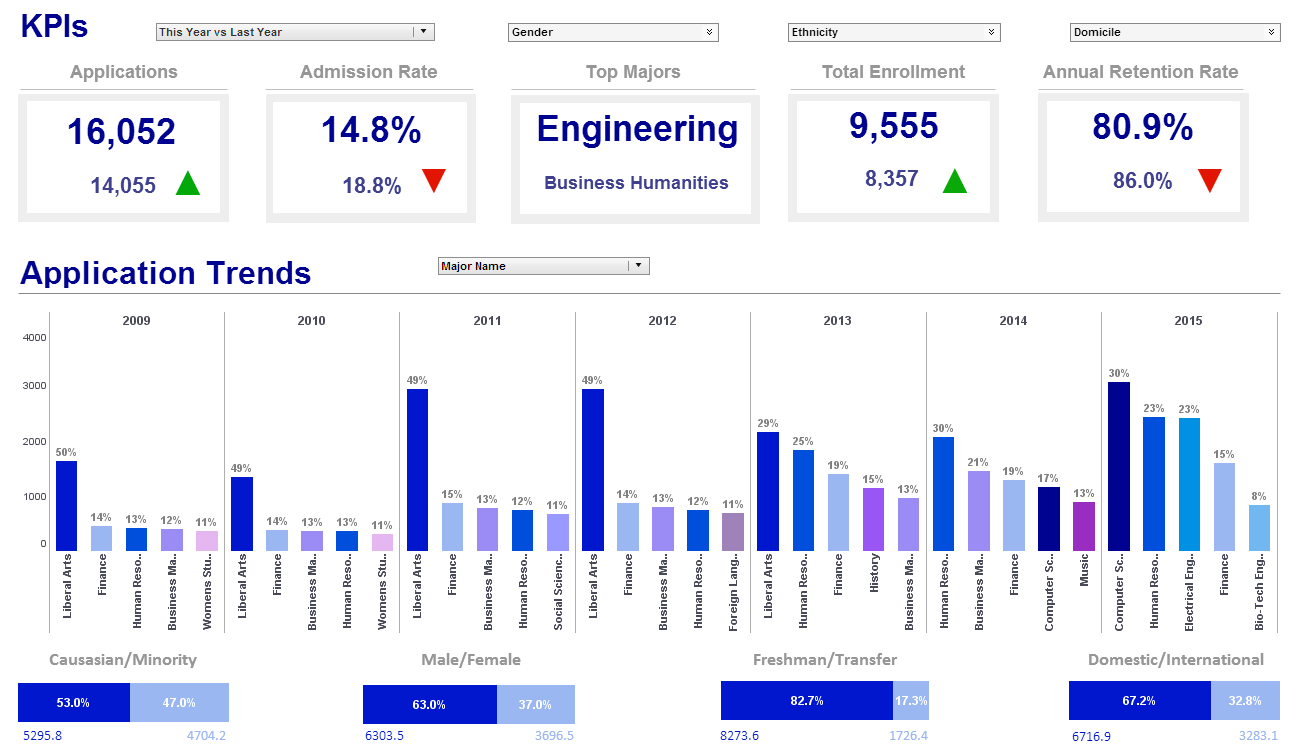Searching for Web-based business intelligence software?
 |
Would you like a more agile, flexible software platform for pulling together disparate data sources for dashboards and reporting? |
 |
Do you want a solution that is quick to deploy and easy to use? |
 |
InetSoft offers a small-footprint, full-featured BI platform that can be deployed on commodity servers. The single Web-based application provides a streamlined, intuitive interface for all users, business executives and database analysts. |
 |
As an innovator in BI products since 1996, InetSoft's award-winning software has been deployed at thousands of organizations worldwide and integrated into dozens of other application providers' solutions serving vertical and horizontal markets of their own. |

 |
Read the top 10 reasons for selecting InetSoft as your BI partner. |
What KPIs and Metrics Do Acupuncture Practices Track with Business Intelligence Software?
Acupuncture practices, like many other healthcare providers, can benefit greatly from using business intelligence (BI) software to track key performance indicators (KPIs) and metrics. These KPIs and metrics help the practice understand its operational efficiency, financial health, patient satisfaction, and overall business performance. Here are some important KPIs and metrics acupuncture practices might track, along with their definitions and significance:
- Patient Volume
- Definition: The total number of patients seen within a specific period (daily, weekly, monthly).
- Significance: Indicates the demand for acupuncture services and helps in planning resources and staffing needs.
- Patient Retention Rate
- Definition: The percentage of patients who return for follow-up treatments.
- Significance: A high retention rate suggests patient satisfaction and effective treatment plans, which are critical for long-term business sustainability.
- New Patient Acquisition
- Definition: The number of new patients who visit the practice within a certain timeframe.
- Significance: Measures the effectiveness of marketing and referral programs and is crucial for growth.
- Average Treatment Cost
- Definition: The average amount charged per treatment session.
- Significance: Helps in pricing strategy analysis and understanding the revenue generated per session.
- Revenue per Patient
- Definition: Total revenue divided by the number of patients.
- Significance: Provides insights into the average spending of each patient and the profitability of treatments offered.
- Treatment Success Rate
- Definition: The percentage of treatments that result in significant patient-reported improvement.
- Significance: Directly linked to patient satisfaction and practice reputation.
- Appointment No-Show Rate
- Definition: The percentage of scheduled appointments where patients did not show up.
- Significance: High no-show rates can indicate issues with scheduling, patient communication, or satisfaction and can lead to lost revenue.
- Patient Satisfaction Score
- Definition: A measure of patient satisfaction, often collected through surveys or feedback forms.
- Significance: High satisfaction scores can lead to better patient retention and more referrals.
- Average Appointment Duration
- Definition: The average time spent per patient appointment.
- Significance: Helps in optimizing scheduling and understanding the efficiency of practitioners.
- Revenue Growth Rate
- Definition: The rate at which the practice's revenue is increasing over time.
- Significance: Indicates the financial health and growth trajectory of the practice.
- Operational Costs
- Definition: Total expenses incurred in running the practice, including rent, salaries, supplies, and utilities.
- Significance: Essential for financial management and profitability analysis.
- Profit Margin
- Definition: The percentage of revenue that exceeds the practice's expenses.
- Significance: Indicates the financial efficiency and profitability of the practice.
- Referral Rate
- Definition: The percentage of new patients referred by existing patients or other healthcare providers.
- Significance: High referral rates can indicate strong patient satisfaction and trust in the practice.
- Practitioner Utilization Rate
- Definition: The percentage of available practitioner hours that are booked with patient appointments.
- Significance: Ensures that practitioners' time is used efficiently and can highlight under or overutilization.
- Cancellation Rate
- Definition: The percentage of appointments that are cancelled by patients.
- Significance: High cancellation rates may indicate issues with patient engagement or scheduling flexibility.
- Wait Time
- Definition: The average time patients wait from their scheduled appointment time until they see the practitioner.
- Significance: Shorter wait times generally lead to higher patient satisfaction.
- Inventory Turnover Rate
- Definition: The rate at which inventory (such as needles, herbs, and other supplies) is used and replenished.
- Significance: Effective inventory management ensures that the practice operates smoothly without overstocking or stockouts.
- Net Promoter Score (NPS)
- Definition: A measure of patient likelihood to recommend the practice to others, typically derived from patient surveys.
- Significance: A high NPS indicates strong patient loyalty and satisfaction.
- Employee Satisfaction Score
- Definition: A measure of staff satisfaction, often collected through internal surveys.
- Significance: High employee satisfaction can lead to better patient care and lower staff turnover.
- Clinic Utilization Rate
- Definition: The percentage of available clinic space and resources that are actively used for patient care.
- Significance: High utilization rates suggest efficient use of practice facilities and resources.
 |
Read how InetSoft saves money and resources with deployment flexibility. |
How Can an Acupuncture Practice Improve Patient Satisfaction Score?
Improving patient satisfaction in an acupuncture practice involves a combination of strategies that enhance the overall patient experience, from the moment they first contact the practice until they complete their treatment. Here are several actionable steps an acupuncture practice can take to improve patient satisfaction scores:
Enhance Communication and Accessibility
- Streamlined Appointment Scheduling
- Implement an easy-to-use online booking system that allows patients to schedule, reschedule, or cancel appointments at their convenience.
- Ensure the practice's contact information is readily available and respond promptly to inquiries.
- Effective Communication
- Communicate clearly and regularly with patients about their treatment plans, appointment reminders, and follow-up care.
- Use multiple channels such as phone calls, emails, and text messages to reach patients effectively.
- Educational Materials
- Provide comprehensive educational materials about acupuncture, its benefits, and what patients can expect during and after treatment.
- Offer resources on lifestyle and wellness practices that complement acupuncture treatments.
Improve the Patient Experience
- Welcoming Environment
- Create a calming and comfortable clinic environment with soothing decor, music, and amenities such as refreshments.
- Ensure that the waiting area is clean, spacious, and inviting.
- Personalized Care
- Take the time to understand each patient's unique needs and health goals. Tailor treatments to address these specific concerns.
- Remember personal details about patients to make them feel valued and remembered during each visit.
- Minimize Wait Times
- Optimize scheduling to minimize wait times and ensure that appointments start on time.
- Communicate any delays promptly and provide updates to waiting patients.
Enhance Clinical Care
- Skilled Practitioners
- Ensure that all practitioners are highly skilled, certified, and up-to-date with the latest acupuncture techniques and best practices.
- Encourage ongoing professional development and training for all staff members.
- Holistic Approach
- Incorporate a holistic approach to care, considering the patient's overall well-being and integrating complementary therapies when appropriate.
- Offer additional wellness services such as herbal medicine, nutritional counseling, and stress management techniques.
- Post-Treatment Follow-Up
- Follow up with patients after their treatment to check on their progress and address any concerns or questions they may have.
- Use follow-up calls, emails, or surveys to gather feedback on their experience and outcomes.
Foster a Positive Practice Culture
- Friendly and Professional Staff
- Ensure that all staff members, from receptionists to practitioners, are friendly, professional, and empathetic.
- Train staff to handle patient interactions with care and respect, making every patient feel welcome and important.
- Consistent Quality of Care
- Maintain a high standard of care consistently across all patient interactions and treatments.
- Implement quality assurance measures to monitor and improve treatment outcomes.
- Patient Feedback System
- Establish a system for collecting and analyzing patient feedback regularly.
- Use surveys, suggestion boxes, and online reviews to gather insights and identify areas for improvement.
Leverage Technology
- Electronic Health Records (EHR)
- Use EHR systems to keep accurate and accessible patient records, facilitating better treatment planning and coordination.
- Ensure patient data is secure and privacy is maintained.
- Patient Portals
- Provide a patient portal where patients can access their health information, treatment history, and educational resources.
- Allow patients to communicate securely with their practitioners through the portal.
Marketing and Community Engagement
- Community Engagement
- Engage with the local community through health fairs, workshops, and educational seminars about the benefits of acupuncture.
- Build partnerships with other healthcare providers to enhance referral networks and patient care continuity.
- Positive Online Presence
- Encourage satisfied patients to leave positive reviews online to build a strong online reputation.
- Actively manage and respond to online reviews and feedback to show that patient opinions are valued and acted upon.
Continuous Improvement
- Regular Training and Development
- Invest in regular training and development programs for all staff members to stay updated on best practices and new treatment techniques.
- Encourage staff to attend workshops, conferences, and other professional development opportunities.
- Benchmarking and Performance Monitoring
- Regularly monitor and benchmark patient satisfaction scores against industry standards.
- Use performance data to identify trends, address weaknesses, and celebrate successes.
 |
View a 2-minute demonstration of InetSoft's easy, agile, and robust BI software. |
More Articles About Web-based BI
Advantages of Using InetSoft's Professional Services - InetSoft's professional business intelligence consulting services are the complement to the company's award-winning dashboard, reporting, and analysis software products. If you are looking to accelerate the deployment or enhancement of InetSoft applications, our staff is available for a wide range of services from training your staff to turnkey application development and deployment...
InetSoft Installation Process - The InetSoft JAR files must be added to the system classpath in order to run the software. The editions and their corresponding JAR files are as follows: Note: The Jar file names are suffixed with _lite for the evaluation version...
Profitability in the Logistics Industry - To maintain profitability in the logistics industry, finding the most profitable transportation method is critical. InetSoft Style Scope allows logistics managers to track, visualize and optimize all relevant logistic processes in an efficient way and get a sense of how the profit is affected by quarters, territory, regions and product size. InetSoft Style Scope with boundaryless self-service analytics provides actionable information that logistics managers can use to immediately lower cost and gain more profit. The powerful self-service analytics of InetSoft Style Scope also help businesses cover important KPIs...
Reporting Tools Used in Professional Sports - Key Performance Indicator (KPI) reporting tools play a crucial role in professional sports organizations by helping them track and analyze various performance metrics to improve team performance, player development, and fan engagement. Here are some KPI reporting tools commonly used in professional sports: Sports Analytics Software: There are various sports analytics software platforms that cater to different needs, such as Catapult Sports and Sportscode. These tools allow teams to collect and analyze data on player performance, game strategy, and injury prevention...

